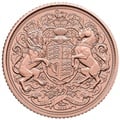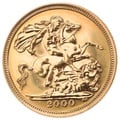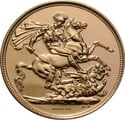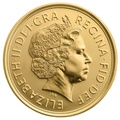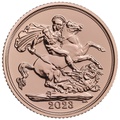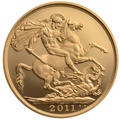Sovereign coin designs
The gold Sovereign is one of the oldest British coins still in production by The Royal Mint. First struck in 1817 following the Great Recoinage of 1816, Sovereign coins were used in common circulation £1 coin, but are now only available in bullion or proof forms, depending on your interest as an investor, collector, or simply somebody looking for a gift.

The gold Sovereign coins of today are the successors of the old English gold sovereigns, first introduced under King Henry VII in 1489. Later adaptations of the coin included the Crown Gold, Unites, Laurels, Broads, and eventually Guineas.
Traditionally the Sovereign features the present monarch on the obverse (front) of the coin, and St George slaying a dragon on the reverse. This design is used on the vast majority of Sovereigns over it's more than 200 year history, but certain special years have received unique designs.
Sovereign specifications:
Gold Sovereign coins weigh 7.98 grams, of which 7.3224 grams is fine gold. This puts the Sovereign at 22 carat purity, which is the gold purity The Royal Mint has always produced these coins at. The remaining metals are primarily copper in modern Sovereigns, to help with the coin’s strength and resilience to damage, but other metals like silver have been used in the past.
The current design of Sovereign is produced at 22.05mm in diameter and with a 1.52mm thickness, but these can fractionally vary depending on the age and condition of the Sovereign.

Sovereign size variations:
There are several types of gold Sovereign based upon their size, including the quarter, half, double, and quintuple sizes.
The smaller sizes are available in bullion and proof finishes, while the larger are proof-only editions, such as this
2005 proof Horatio Nelson quintuple Sovereign.
Learn more about
Sovereign coin specifications.
Sovereign reverse designs:
Italian sculptor and artist Benedetto Pistrucci came to London in 1816 to show off his artistic talents. He caught the eye of
Lady Spencer, who commissioned him to reproduce a wax model of Saint George and the Dragon (as made by Nathaniel
Marchant) but in Greek style, with Knight of the Garter regalia.
Upon completion he was commissioned once again, this time by the Master of the Mint, to produce models for the new
British coinage. Pistrucci completed the design and even engraved the dies himself due to the Mint’s engravers not being
able to accurately replicate his work.

Benedetto Pistrucci’s original design was a gold Sovereign with a thick border bearing the words ’HONI SOIT QUI MAL Y PENSE’, which is French for “Evil unto him who thinks evil of it”. These words also feature on the royal coat of arms and the Order of the Garter.
The gold sovereign design sees St George riding a horse and trampling a dragon, whilst wearing a plumed helmet, flowing cape, and wielding a broken spear.

Four years later, Pistrucci’s design was altered. Gone was the latin and the thick border, allowing for a larger image of St George and in greater detail.
The broken spear was replaced for a mythical sword, known as Ascalon.

Commissioned in 1823, King George wanted a new set of coin designs. French engraver and medallist Jean Baptiste Merlen obliged, and the new shield Sovereign was born.

King William came to the British throne in 1830. He commissioned the Paris Mint’s Jean Baptiste Merlen to update his previous shield design made for George IV to be a little more detailed.
Interestingly, William was the only monarch not to use Pistrucci’s St George on the gold Sovereign at any time during his reign.

Jean Baptiste Merlen’s work for the Royal Mint continued when Queen Victoria was coronated, with an updated version of the shield once more.
The Royal Arms are a lot clearer on this image, the crown is smaller, and a wreath now flanks the shield.
View our full range of Queen Victoria shield back Sovereigns

After 46 years of the Royal Coat of Arms, the gold Sovereign returned to Pistrucci’s remodelled design of St George and the Dragon, which appeared on Sovereigns henceforth and still do to this day.
Browse our full range of
Queen Victoria young head Sovereigns
bearing St George and the Dragon on the reverse.

To commemorate the original anniversary of the old gold Sovereign, made on 28 October 1489 for Henry VII,
the Royal Mint asked Bernard Sindall to create a special edition coin for their collection.
The design heavily features the double Tudor rose as well as a crowned shield of the Royal Coat of Arms.
The aim was to mimic the style of hammered Sovereigns made during Henry’s reign.
View
the obverse side
of this coin featuring Queen Elizabeth II.

Another commemorative coin, this Sovereign was produced by the Royal Mint to honour Queen Elizabeth II’s Golden Jubilee.
The coin was designed by Timothy Noad and is a throwback to the shield reverse used by Queen Victoria, with a modest crown sat upon the Coat of Arms and flanked by a wreath.

Three years later, the Royal Mint commissioned Timothy Noad once again to reimaging the classic St George
and the Dragon coin.
His design was less classical in its artwork and a lot bolder and more of a portrait of St George. In the design
he has a more medieval visor-style helmet, a broader sword, and is mid-swing against a more medieval style
dragon. St George is also brandishing a shield with a cross on it.
View the 2005 proof half Sovereign, complete with Royal Mint box and Certificate of Authentication.

Much like in 2002, the Diamond Jubilee Sovereign was commemorative in honour of 60 years of the Queen’s reign. British sculptor Paul Day won the Royal Mint’s competition to have his design minted.
The Sovereign’s reverse features a more aggressive and unsightly dragon roaring at the lion, while St George lances the beast in the back.
Interested in this coin? Why not buy the 2012 Diamond Jubilee gold half Sovereign.

In 2017, The Royal Mint marked 200 years of what we deem the modern gold Sovereign coin by adding a small shield emblem with the number 200 above it to the left of the year date, seen on the image here in a red circle.
Demand for this coin is high due to its anniversary status. Please be aware that The Royal Mint are no longer producing this coin.
At BullionByPost we buy back gold as well as sell. Customers can sign up for a stock alert in the event we buy back
a
2017 gold Sovereign,
but interest will be dealt with on a first come, first serve basis.

To mark the historic Platinum Jubilee of Her Majesty Elizabeth II, The Royal Mint issued a special Royal Coat of Arms shield design by artist Timothy Noad for the 2022 Sovereign.
This coin proved to be exceptionally popular with investors and collectors alike. The unique design was widely appreciated, and marks one of the most historic moments in UK royal history. Following the sad passing of Her Majesty, this will also be the final Elizabeth II Sovereign, making it a truly special coin.

To mark the passing of Her Majesty Elizabeth II, The Royal Mint produced a second Sovereign in 2022, a very unusual occurrence. The coin features a beautiful interpretation of the Royal Arms on the reverse, and is the first Sovereign in the Series history to feature King Charles III.
The beautiful design on the
2022 Memorial Sovereign
has proven a favourite of investors and collectors alike, and makes the two 2022 Sovereigns a must-have coin.
Another variation of Sovereign coin designs would be mint marks. Throughout the years, The Royal Mint has produced its gold Sovereigns at a variety of refineries across the world, as part of the British Empire and the Commonwealth.
Most of these coins were minted in London and now Llantrisant, which are unmarked, but those minted away from the UK bear distinguishing marks to flag up their origin.
These distinguishing marks can be found primarily above the year of mintage as a small letter, or in some older cases they can be found near the bottom of the coin in different places – beneath a neck, wreath or shield typically.

London & Llantrisant: 1817 – 1917, 1925, 1957 – Present: No Mint Mark
Australia: 1855 – 1931: S (Sydney), M (Melbourne), P (Perth)
India: 1918: I (For India; minted in Bombay)
Canada: 1908 – 1919: C (For Canada, minted in Ottawa)
South Africa: 1923 – 1932:
SA
(For South Africa, minted in Pretoria)
More detailed information about Sovereign mint marks
The Monarchs:
Below are all the different monarchs whose portraits featured on what we know as the modern-day gold Sovereign coins, as well as different variations in the coin reverses.
View our range of gold Sovereigns by year.
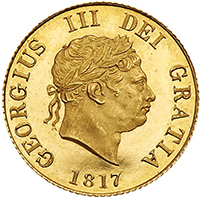
Gold Sovereigns were first introduced in 1817, towards the end of King George III’s reign. There was only one design
– a right-facing portrait of the King on the front, and the thick-rimmed St George and the Dragon design on the back.
The coin bears the French ’HONI SOIT QUI MAL Y PENSE’, which translates as “Evil unto him who thinks evil of it”.
 The George IV gold Sovereign coins ditched the thicker border in favour of larger portraits of
The George IV gold Sovereign coins ditched the thicker border in favour of larger portraits of
both the King himself on the obverse, and St George on the reverse. George’s portrait is
facing to the left, to differ from his predecessor, and Pistrucci’s St George was updated to
now wield a sword.
There are two versions of George IV gold Sovereigns:
Laureate Head (wreath) – 1821 to 1825
Bare Head – 1825 to 1830
If you’re interested in George IV, why not take a look at a King George crown.
Like George IV before him, King William had two gold Sovereigns produced during his reign. These were
only fractionally different, sporting two different busts of the King. The one has a more furrowed expression
and greater detail to the King’s hair, while the other portrays the King as more peaceful.
An unknown number of proof Sovereigns were commissioned for minting in 1830, but it’s not known
how few of these were made. The coin is incredibly rare, and only a couple have ever been auctioned.
Queen Victoria was the first monarch to have more than two design variations of gold Sovereigns during her reign, reaching a grand total of four.
Young Head Victoria with the Shield reverse (1837 – 1887)
The youngest of the three portraits, this gold Sovereign featured Queen Victoria on the obverse and an updated version of Merlen’s Royal Arms shield on the reverse.
Production was chiefly in London, though later versions were also made in Sydney and in Melbourne. Production of this coin ended before the Perth mint opened.
No coins were made outside of London until 1871.
Years not produced:
1840, 1867, 1876, 1875-1887 (London)

Young Head Victoria with the St George reverse (1871 – 1887)
In 1871 the Royal Mint changed from using the shield on the gold Sovereigns and back to the classic St George and the Dragon reverse design.
Like the other young head gold coin, production took place in London, Melbourne and Sydney.

Jubilee Head Victoria (1887 – 1893)
Following Queen Victoria’s Golden Jubilee in 1887, the Royal Mint ceased production of gold Sovereigns using her young portrait, instead updating the coins to use an image that closer reflected the monarch’s true age.
The jubilee portrait is one of the most recognisable images of Queen Victoria and was designed by medallist and sculptor Joseph Edgar Boehm.
Years not produced:
1893 (London)

Old Head Victoria (1893 – 1901)
The final portrait of Queen Victoria is dubbed the ‘Old Head’. The image, designed by Thomas Brock, shows a more mature Queen and reflected her position as a grandmother and – at the time – the longest serving monarch in British history.
Victoria is at a slightly different angle compared to typical coin profiles. She is wearing a tiara, perhaps that designed by Prince Albert, her late husband, and has a widow’s veil – a style of dress she pursued after Albert’s passing and until her own death.
Years not produced: 1897 (London), 1893-1898 (Perth)
Only one design of gold Sovereign was produced by the Royal Mint for King Edward VII. This coin was the classic side portrait bust of the King, with texture detail marking his hair, beard, and moustache.
The inscription around the Sovereign reads EDWARDVS VII D: G: BRITT: OMN: REX F: D: IND: IMP.
A matte edition proof Sovereign of Edward VII was made in 1902 as part of specimen sets.
Years not produced: 1902-1907 (Canada)
Production of gold Sovereigns during the reign of King George V was mixed due to the First World War and the prospect of the second by the end of his reign.
Gold Sovereigns were produced in London, Sydney, Melbourne, Perth, Ottawa, Bombay, and Pretoria as the British Empire peaked in terms of global reach.
Years not produced:
1918-1920, 1922-1924, 1926-1936 (London), 1927-1936 (Sydney),
1932-1936 (Melbourne), 1912, 1915, 1920-1936 (Canada), 1925, 1932-1936 (Perth),
1911-1922 & 1933-1936 (South Africa). Sovereigns in Bombay, India were
only
produced in 1918.
Only TWO sovereigns were made during Edward VIII’s brief reign. These were both proof coins, and intended as forerunners to the bullion Sovereign production due to start on January 1st 1937.
The two coins both state 1937 as the year of their production, despite being made in 1936. Edward also broke tradition by facing the same way as his father, George V, for his portrait. This, he said, was to use his "good side"
for the coin depictions, and captured his classic side parting hairstyle.
One of the coins sold at auction in 2014 for £516,000 - a record for a British coin.
No sovereigns were made during George VI’s reign for individual sale, however 5,501 proof versions were made
in Sovereign and Double Sovereign sizes as part of a four-coin gold proof set (also known as a specimen set)
released to mark George's coronation.
The only other Gold Sovereigns handled by the Royal Mint during George's reign were restrikes of 1925 Sovereigns. 886,000 of these coins - previously believed to be scarce - were restruck between 1949 and 1952.
View our Quintuple Sovereign bearing King George VI's portrait.
For the first few years of Queen Elizabeth’s reign, the Royal Mint did not produce any gold Sovereigns – continuing its halted production post-war. Demand from the Middle East and other nations that still used gold Sovereigns forced the Mint’s hand and, in 1957, production restarted in London, before migrating to Wales in the mid-1970s.
All gold Sovereigns bearing Elizabeth’s head on the obverse feature Pistrucci’s St George and the Dragon on the reverse unless a commemorative edition.

First Portrait: Young Elizabeth (1957 – 1970)
The first portrait of Elizabeth II was the only one that was produced before the United Kingdom adopted decimalisation. The Queen’s first coin was produced one year after her coronation, age 26, and was sculpted by
Mary Gillick, but the design never made it onto a gold Sovereign until their recommission in 1957.
In this portrait, the young Queen is wearing the Laureate crown or the Laurel wreath. The latin accompanying the Queen’s portrait is DEI GRATIA REGINA F.D., which translates as ‘By the Grace of God, Queen’ and ‘Defender of the Faith’.
Coins from 1957 specifically differ from other young Elizabeth Sovereign coins as they had a finer milled edge than
other, later Sovereigns. Production was in London.
Years not produced:
1960-1961, 1969-1970

Second Portrait: Decimal Elizabeth (1974 – 1984)
The Queen’s second portrait was introduced on 5p and 10p coins as a test from 1968, and then introduced across
the full range of Royal Mint coins in 1970-71 with decimalisation.
Arnold Machin, the sculptor and coin specialist, was chosen to design the second portrait of Queen Elizabeth.
She wears the Girls of Great Britain and Ireland tiara (a wedding gift from her grandmother), and the same latin
appears as on the first Sovereign.
Production was mostly in London, before the Royal Mint moved to a larger facility in South Wales during the 1970s.
Years not produced:
1970-1973, 1975, 1977, 1983-1984 (Bullion)
View the
1989 special edition Sovereign reverse

Third Portrait: PROOF ONLY (1985 – 1997)
Gold Sovereigns between 1985 and 1997 were issued by the Royal Mint in proof finish only. This format is complete with box and Certificate of Authentication but meant an additional premium for buyers compared to the bullion coins.
The design of the middle-aged Queen was by Raphael Maklouf and sees the monarch wearing the King George IV State Diadem (worn during the annual State Opening of Parliament) and Diamond Jubilee drop pearl earrings.
As mentioned earlier on this page, there was a 1989 special edition Gold Sovereign issued, marking 500 years since the first ever Sovereign was produced by The Royal Mint. This coin bears the Tudor rose on the reverse and Queen Elizabeth on the obverse.

Fourth Portrait (1998 – 2014)
The fourth portrait of Queen Elizabeth is probably the most recognised of all images of the Queen. Designed by Ian Rank-Broadley, the coin sports a more mature monarch and reflects her status as a grandmother, as well as a long-reigning royal. The portrait is also slightly larger than previous iterations – a deliberate move by the artist as a nod to her significance in British culture.
The coins were only available in proof finish until 2000 and, at the change of the millennium, the Royal Mint resumed production of uncirculated bullion gold Sovereigns.
View the
2002 special edition Sovereign reverse.
View the
2005 special edition Sovereign reverse.
View the
2012 special edition Sovereign reverse.

Fifth Portrait (2015 – 2022)
The fifth and likely final portrait sovereign design of Queen Elizabeth II was debuted in 2015, having been designed by the Royal Mint’s own engraver Jody Clark. This is the first time the Mint has had one of its own employees design a sovereign portrait for a monarch.
Like the fourth portrait borrowed elements from the decimal head, the fifth portrait borrows from the third; the King George IV State Diadem and Diamond Jubilee drop pearl earrings make a return in Clark’s design. The milled edge and lettering are very crisp to look at, showing the progress in modern minting technology.
 Following the passing of Elizabeth II, Charles III became king in 2022. A new design by Martin Jennings was produced for all coinage featuring King Charles III. This design debuted on the Sovereign coins in 2022 with the Memorial Sovereign.
Following the passing of Elizabeth II, Charles III became king in 2022. A new design by Martin Jennings was produced for all coinage featuring King Charles III. This design debuted on the Sovereign coins in 2022 with the Memorial Sovereign.
The design features King Charles III looking left, following the tradition where each subsequent monarch faces in the opposite direction to their predecessor.
Browse our full range of Gold Sovereigns.
For any customer support please call us on 0121 634 8060 or email us at support@bullionbypost.co.uk.
- How To Buy Gold
- How to Buy?
- Payment Options
- Delivery Options
- Gold Storage
- Storage at Brink's
- Gold Investment Guide
- Why buy gold?
- Is gold a good investment?
- Why physical gold?
- Best time to buy gold?
- Gold bars vs coins?
- Gold vs Silver
- Gold - Silver Ratio explained
- VAT on bullion
- CGT on bullion
- Legal tender coins
- Top 5 Gold Investments
- Top 5 Silver Investments
- Gold vs ISAs
- Gold vs Buy-to-Let
- Gold vs FTSE 100
- Gold vs Bitcoin
- Where to buy gold?
- Why buy from us?
- Where to sell gold?
- Coin Shops
- Gold Price Forecasts
- Top 10 Gold Producers
- Top 10 Gold Reserves
- Gold Britannia vs Sovereign
- Britannia coin designs
- Sovereign coin designs
- Sovereign Mintages
- Sovereign mint marks
- British coin specs
- What is a proof coin?
- Royal Mint bullion
- The Queen's Beasts
- Royal Mint Lunar Coins
- Bullion Refiners
- British coin mints
- Krugerrands
- Gold Tola - India & Pakistan
- Bullion Index






